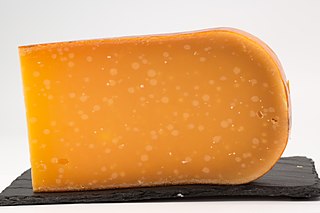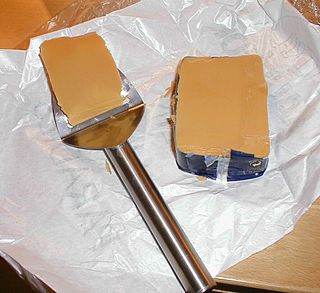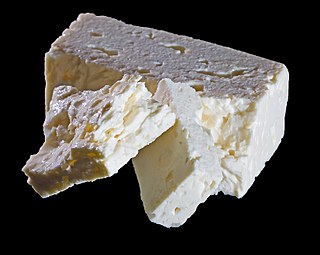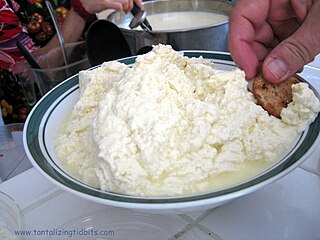
Cheddar cheese is a natural cheese that is relatively hard, off-white, and sometimes sharp-tasting. Cheddar originates from the English village of Cheddar in Somerset.

Gruyère is a hard Swiss cheese that originated in the cantons of Fribourg, Vaud, Neuchâtel, Jura, and Berne in Switzerland. It is named after the town of Gruyères in Fribourg. In 2001, Gruyère gained the appellation d'origine contrôlée (AOC), which became the appellation d'origine protégée (AOP) as of 2013.

Gouda cheese is a sweet, creamy, yellow cow's milk cheese originating from the Netherlands. It is one of the most popular cheeses worldwide. The name is used today as a general term for numerous similar cheeses produced in the traditional Dutch manner.

Brunost is a common Norwegian name for mysost, a family of cheese-related foods made with whey, milk, and/or cream. The term is often used to refer to Fløtemysost or Gudbrandsdalsost, which are the most popular varieties. Brunost is primarily produced in Norway and is popular there, and in South Korea. It is regarded as one of the country's most iconic foodstuffs, and is considered an important part of Norwegian gastronomical and cultural identity and heritage.

Feta is a Greek brined white cheese made from sheep's milk or from a mixture of sheep and goat's milk. It is soft, with small or no holes, a compact touch, few cuts, and no skin. Crumbly with a slightly grainy texture, it is formed into large blocks and aged in brine. Its flavor is tangy and salty, ranging from mild to sharp. Feta is used as a table cheese, in salads such as Greek salad, and in pastries, notably the phyllo-based Greek dishes spanakopita "spinach pie" and tyropita "cheese pie". It is often served with olive oil or olives, and sprinkled with aromatic herbs such as oregano. It can also be served cooked, as part of a sandwich, in omelettes, and many other dishes.

Danish cuisine originated from the peasant population's own local produce and was enhanced by cooking techniques developed in the late 19th century and the wider availability of goods during and after the Industrial Revolution. Open sandwiches, known as smørrebrød, which in their basic form are the usual fare for lunch, can be considered a national speciality when prepared and decorated with a variety of fine ingredients. Hot meals are typically prepared with meat or fish. Substantial meat and fish dishes includes flæskesteg and kogt torsk with mustard sauce and trimmings. Ground meats became widespread during the industrial revolution and traditional dishes that are still popular include frikadeller, karbonader and medisterpølse. Denmark is known for its Carlsberg and Tuborg beers and for its akvavit and bitters, but amongst the Danes themselves imported wine has gained steadily in popularity since the 1960s.

Ricotta is an Italian whey cheese made from sheep, cow, goat, or Italian water buffalo milk whey left over from the production of other cheeses. Like other whey cheeses, it is made by coagulating the proteins that remain after the casein has been used to make cheese, notably albumin and globulin.

Paneer, also known as ponir, is a fresh acid-set cheese common in the Indian subcontinent made from full-fat buffalo milk or cow milk. It is a non-aged, non-melting soft cheese made by curdling milk with a fruit- or vegetable-derived acid, such as lemon juice.

Danablu, often marketed under the trademark Danish Blue Cheese within North America, is a strong, blue-veined cheese. This semi-soft creamery cheese is typically drum- or block-shaped and has a yellowish, slightly moist, edible rind. Made from full fat cow's milk and homogenized cream, it has a fat content of 25–30% and is aged for eight to twelve weeks.
Norwegian cuisine in its traditional form is based largely on the raw materials readily available in Norway and its mountains, wilderness, and coast. It differs in many respects from continental cuisine through the stronger focus on game and fish. Many of the traditional dishes are the result of using conserved materials, necessary because of the long winters.

Fontina is a cow's milk cheese, first produced in Italy. Over time, production of Fontina has spread worldwide, including to the United States, Denmark, Sweden, Canada, France and Argentina.

Esrom, or Danish Port Salut cheese is a Trappist-style pale yellow semi-soft cow's milk cheese with a pungent aroma and a full, sweet flavour.

Castello is a brand of cheeses produced by Arla Foods amba, a Danish agricultural marketing cooperative based in Viby, Aarhus. Worldwide, a variety of cheeses are marketed under the Castello name, including semi soft cheeses, semi hard cheeses, blue cheeses, and cream cheeses.

Uruguayan cuisine is a fusion of cuisines from several European countries, especially of Mediterranean foods from Spain, Italy, Portugal and France. Other influences on the cuisine resulted from immigration from countries such as Germany and Scotland. Uruguayan gastronomy is a result of immigration, rather than local Amerindian cuisine, because of late-19th and early 20th century immigration waves of, mostly, Italians. Spanish influences are very abundant: desserts like churros, flan, ensaimadas yoo (Catalan sweet bread), and alfajores were all brought from Spain. There are also all kinds of stews known as guisos or estofados, arroces, and fabada. All of the guisos and traditional pucheros (stews) are also of Spanish origin. Uruguayan preparations of fish, such as dried salt cod (bacalao), calamari, and octopus, originate from the Basque and Galician regions, and also Portugal. Due to its strong Italian tradition, all of the famous Italian pasta dishes are present in Uruguay including ravioli, lasagne, tortellini, fettuccine, and the traditional gnocchi. Although the pasta can be served with many sauces, there is one special sauce that was created by Uruguayans. Caruso sauce is a pasta sauce made from double cream, meat, onions, ham and mushrooms. It is very popular with sorrentinos and agnolotti. Additionally, there is Germanic influence in Uruguayan cuisine as well, particularly in sweet dishes. The pastries known as bizcochos are Germanic in origin: croissants, known as medialunas, are the most popular of these, and can be found in two varieties: butter- and lard-based. Also German in origin are the Berlinese known as bolas de fraile, and the rolls called piononos. The facturas were re-christened with local names given the difficult German phonology, and usually Uruguayanized by the addition of a dulce de leche filling. Even dishes like chucrut (sauerkraut) have also made it into mainstream Uruguayan dishes.

There are many different types of cheese. Cheeses can be grouped or classified according to criteria such as length of fermentation, texture, methods of production, fat content, animal milk, and country or region of origin. The method most commonly and traditionally used is based on moisture content, which is then further narrowed down by fat content and curing or ripening methods. The criteria may either be used singly or in combination, with no single method being universally used.
Queijo prato, named after the shape it was originally made by the immigrants, is a Brazilian soft cheese, similar to the Danish cheese danbo. It is one of the most popular Brazilian cheeses.

Butterkäse is a semi-soft, cow's milk cheese moderately popular in Germanic Europe, and occasionally seen in the rest of the cheese-eating world. Although primarily produced in Germany, some Butterkäse is produced in Wisconsin.

Argentine cheese is by far the most produced dairy product in the country, making Argentina the second largest cheese producer in Latin America and among the top 10 cheese-producing countries in the world. In addition, Argentina is the Latin American country that consumes the most cheese, with 12 kilos per capita per year. Production is mainly centered in the provinces of Córdoba, Santa Fe and Buenos Aires, in the Pampas region of the central and east-central parts of the country.
















